
By Heidi Hirsh, Natural Resources Management Specialist - NOAA Fisheries Service, Marine National Monuments Program
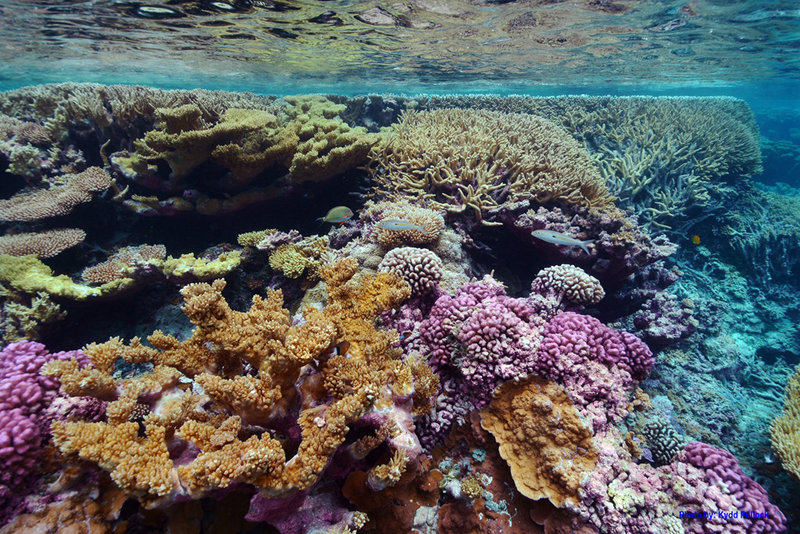
Palmyra Atoll National Wildlife Refuge is home to some of the most pristine coral reefs in the world. Image courtesy of Kydd Pollock. Download larger version (jpg, 619 KB).
Palmyra Atoll and Kingman Reef are home to some of the healthiest marine ecosystems in the world. They are reported to be among the most predator-dominated and biomass-rich reefs and atolls in the Central — and maybe the entire — Tropical Pacific Ocean. In 2010, one report stated, “Kingman in particular is recognized as a near-pristine relic of natural reef ecosystems, and now represents the new baseline standard against which to compare other Central Pacific reefs degraded by human impact” (Maragos, et al., 2008).
From 2000 to 2016, NOAA Pacific Reef Assessment and Monitoring Program scientists and partners conducted monitoring in the Pacific Remote Islands Marine National Monument, now known as Pacific Islands Heritage Marine National Monument, at Palmyra and Kingman. Their findings show coral bleaching and stress from climate change. However, these ecosystems still thrive with great diversity and an abundance of marine life.
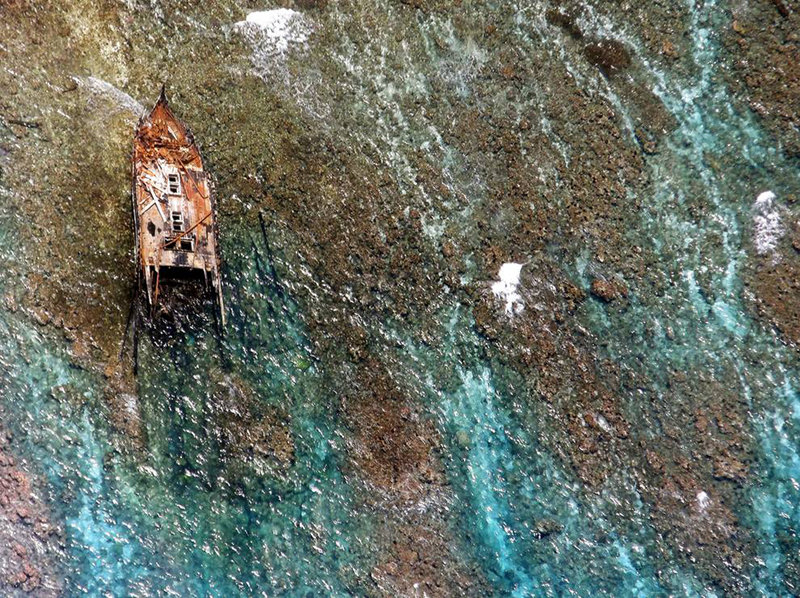
The iron that leached into the environment from this shipwreck on Palmyra Atoll and Kingman Reef had encouraged the growth of an invasive green algae. Image courtesy of Jim Maragos, USFWS. Download larger version (jpg, 592 KB).
Though the above is great news, Palmyra Atoll and Kingman Reef are not free from human disturbances like abandoned shipwrecks, which can negatively affect ecosystems.
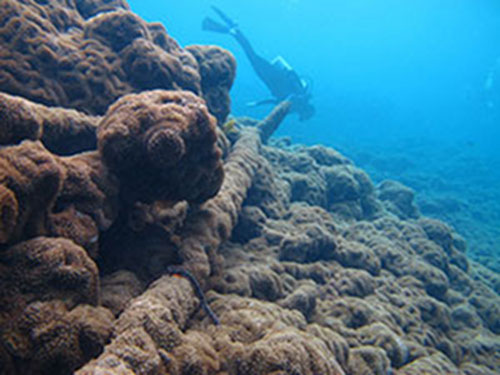
A carpet of the invasive corallimorph that is gaining nutrients from the wreck’s iron. Image courtesy of Susan White, USFWS. Download image (jpg, 48 KB).
For example, within the last 15 years, two shipwrecks were abandoned in Palmyra and one in Kingman. They created a phenomenon called a "phase shift." A phase shift happens when once vibrant coral reefs become dominated with a single species and undergo relatively rapid degradation. Referred to as "black reefs," they become drab and dark in color. The iron in the Palmyra and Kingman shipwrecks fueled the growth of invasive organisms. In particular, corallimorph (an anemone-like organism closely related to reef-building corals) at Palmyra Atoll and filamentous algae at Kingman Reef smothered extensive areas of once-healthy, diverse coral.
The U.S. Fish and Wildlife Service (USFWS) manages the Palmyra Atoll and Kingman Reef National Wildlife Refuges within the Monument waters. They secured $5.5 million to have the three shipwrecks removed. In January 2014, they removed the F/V Hui Feng No. 1, a 121-foot steel-hulled longline fishing vessel, and the Rust Island, a 1940s-era 64-foot by 28-foot steel pontoon barge, from Palmyra and an 85-foot teak fishing vessel of unknown origin from Kingman.
To remove the wrecks, the USFWS developed an elaborate plan involving cranes, barges, divers with surface-supplied air, and torches and saws. With the utmost care, they cut the wrecks into smaller pieces and removed them without damaging the healthy, surrounding corals. They transported a whopping one million pounds of scrap metal and materials to Long Beach, California, where it is being recycled and made into rebar or being disposed.
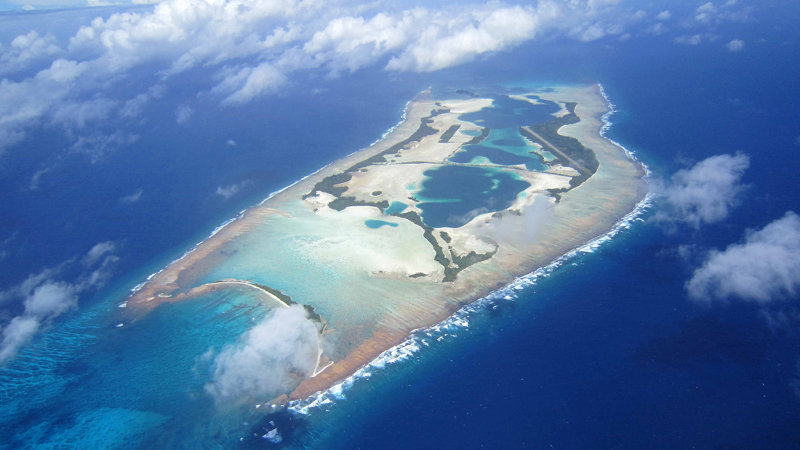
An aerial view of Palmyra from the east end. Image courtesy of Graeme Gale. Download larger version (jpg, 1.6 MB).
The USFWS is conducting corallimorph control and removal efforts for the next several years, as well as transplanting corals to the shipwreck removal sites. Palmyra Atoll exhibits a very resilient ecosystem. Mangers have confidence that controlling and removing corallimorph will allow the once-beautiful coral reefs of the western terrace to recover naturally.
The USFWS managed this successful and complex operation. Global Diving and Salvage of Seattle, Washington, and Curtin Maritime of Long Beach, California, assisted them. The USFWS also collaborated with multiple partner agencies including The Advisory Council on Historic Preservation, U.S. Army Corps of Engineers, U.S. Coast Guard, U.S. Environmental Protection Agency, NOAA, and The Nature Conservancy.
The Nature Conservancy owns Cooper Island within Palmyra and manages the atoll in partnership with the USFWS. In July 2004, The Nature Conservancy established the Palmyra Atoll Research Consortium (PARC). It fosters collaborative multi- and inter-disciplinary research. The consortium includes scientists from around the globe, including those from Stanford University, Scripps Institution of Oceanography, American Museum of Natural History in New York City, California Academy of Sciences, University of California at Santa Barbara, University of California at Irvine, University of Hawaiʻi, U.S. Geological Survey, and Victoria University of Wellington in New Zealand.
Palmyra functions as a living laboratory for terrestrial and marine ecosystems. Scientists are researching everything from the ocean currents to the various organisms that live there. The research conducted on global climate change, coral reefs, marine restoration, and invasive species at Palmyra serves to inform conservation strategies for island ecosystems throughout the Pacific and around the world.
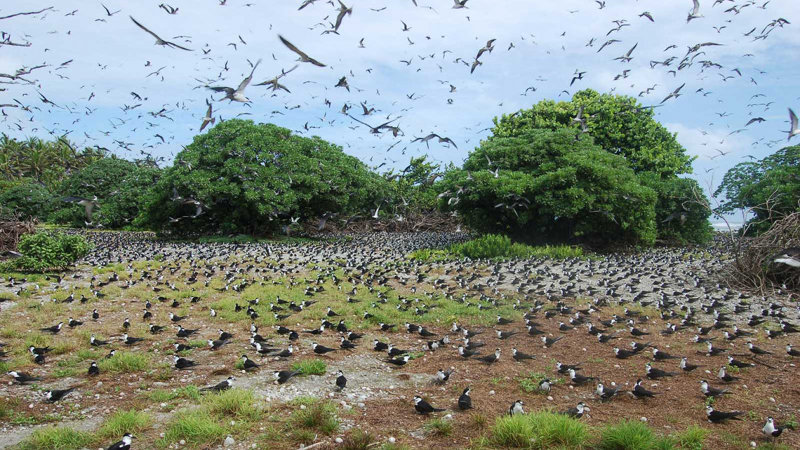
A sooty tern colony on Palmyra Atoll. Image courtesy of Susan White, USFWS. Download larger version (jpg, 622 KB).
Two successful projects conducted at Palmyra include:
Cutlip, Kimbra. (2017, January 31). A New View of Marine Protected Areas. GFW in Action. Retrieved from http://blog.globalfishingwatch.org/2017/01/a-new-view-of-marine-protected-areas/
Maragos, et al., Chapter 16, US Coral Reefs in the Line and Phoenix Islands, Central Pacific Ocean: Status, Threats, and Significance. In: B.M. Riegl and R.E. Dodge (eds.), Coral Reef of the USA, © Springer Science + Business Media B.V. 2008.